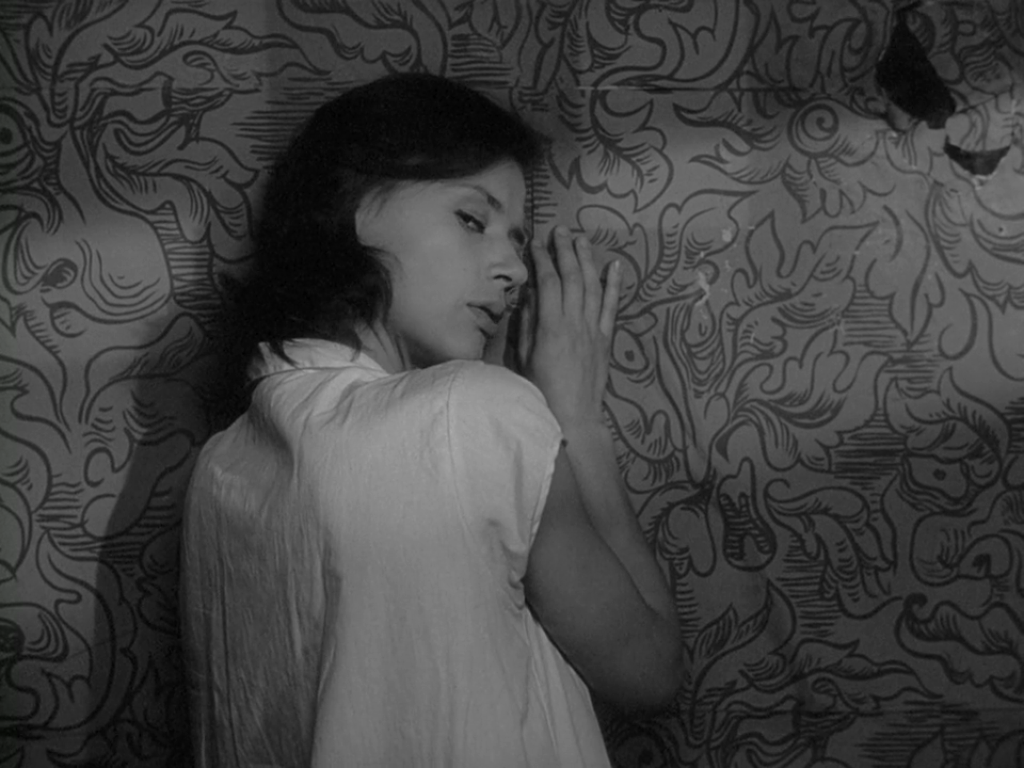There’s something in the way Harriet Andersson moves. Throughout the Swedish actress’ 45-year career, not counting a small role in Lars von Trier’s “Dogville” (2003), she effortlessly commanded the screen while communicating sharp emotions without saying a word. The French New Wave filmmakers recognized Andersson’s appeal, as her fourth wall gaze in “Summer with Monika” (1953) inspired the closing shots of both François Truffaut’s “The 400 Blows” (1959) and Jean-Luc Godard’s “Breathless” (1960)—two early classics of La Nouvelle Vague. And the legendary Swedish filmmaker Ingmar Bergman certainly admired the former theatre performer, as he cast her in several of his most ambitious features. Yet Andersson remains one of cinema’s most undervalued icons.
Three of Andersson’s most beloved Bergman films—“Summer with Monika,” “Through a Glass Darkly,” (1961) and “Cries & Whispers” (1972)—are distinctly Swedish and stylistically unique. Andersson portrays naturalistic women, all of whom have suffered some type of abuse, whether it’s emotional, spiritual or physical. Her characters are relatable and beautiful, but not necessarily accessible. Andersson connects through small gestures and glances, only to create distance through those same movements. There is subtext behind the subtext. Monika (“Summer with Monika”), Karin (“Through a Glass Darkly”) and Agnes (“Cries & Whispers”) all have important stories to tell, but they also have other places to be. And they’ll leave you wondering about tomorrow and beyond.
“Let’s go away and never come back. We’ll see the whole wide world. Are you game?”
In 1953, Ingmar Bergman’s “Summer with Monika” made headlines for its sexual themes and provocative imagery. Barely 20 years old, Andersson portrays a street-smart girl, Monika, who embraces her sexuality while examining her influence over men. At home, Monika’s father emotionally and physically abuses her, pushing the girl towards Lars Ekborg’s Harry, a co-worker. The young lovers enjoy a romantic summer together before confronting the long-term consequences of their decision-making. Harry seeks to settle down, but Monika looks for physical connections when domestic life becomes increasingly difficult.

In her feature debut, Andersson delivers a raw performance but doesn’t move entirely gracefully. Yet that’s part of Monika’s appeal, as both the actress and character haven’t yet refined themselves as mature women. Monika chews away on gum while giving side-eye glances and affirmative glances, too. She calculates her actions and then proceeds. She stops and moves. Over and over, Monika transforms from girl to woman, woman to girl. For Harry, this type of inadvertent and staged behavior is obviously frustrating, as Monika’s natural movements reveal more than just her youthful excitement or inner turmoil. Channeling her theatre background, Andersson utilizes expressive non-verbals, and Bergman knows just how to frame her.
As film historian Peter Cowie has noted, it’s significant that Bergman hadn’t yet begun collaborating with cinematographer Sven Nykvist, who later shot both “Through a Glass Darkly” and “Cries & Whispers” (among others). For “Summer with Monika,” Bergman worked with Gunnar Fischer, who employed a studio style in contrast to Nykvist’s more naturalistic approach. With that said, Fischer does indeed capture the charming naiveté of both Andersson and Monika during the outdoor sequences. When Monika leaves the nest, Andersson carries herself like a wild child. She’s self-aware but not completely secure with her closest relationships. Like so many women or men her age, she hasn’t quite found her place in the world, or realized the long-term effects of her behavior. Because of this imbalance, Andersson has extra room to exaggerate her actions, bringing more depth to her character while naturally drawing attention to her physical form. For a young actress, that’s a tricky task, yet Andersson successfully complements her raw talent with performative restraint in pivotal moments. And this applies to the film’s most famous shot, late in the film, when Monika stares directly at the camera, breaking cinematic taboos while breaking hearts, too. Andersson is accessible, however Monika is not.

In this iconic first role for Andersson, emotional and physical abuse influences her character’s actions. When Monika struggles, Bergman emphasizes subtle movements while Andersson naturally commands her own attention. During a movie theatre sequence, Monika’s toes poke into the ground, and this passing image is not inconsequential, as it’s a visual that Andersson and Bergman would use eight years later for “Through a Glass Darkly,” and then over a decade after that for “Cries & Whispers.” But it’s not toes that most people remember about “Summer with Monika.” It’s the alluring gaze, and the full lips, that made Andersson an immediate sex symbol.
“There’s just one thing you haven’t the slightest clue about. Life itself.”
For Bergman’s 1961 existential classic “Through a Glass Darkly,” he enlisted Nykvist as his new cinematographer. Visually, the minimalistic aesthetic illuminates Andersson’s spectacular performance as a schizophrenic woman, Karin, looking for the presence of God in her everyday life. In contrast to the mostly effervescent “Summer with Monika,” this film initially feels overwhelming as Johann Sebastian Bach’s Cell Suite No.2 in D Minor plays over the opening credits. However, Bergman’s characters liven up the introductory sequence, and Nykvist makes a visual statement by framing Andersson, through a wide shot, next to her brother, their home and the surrounding trees. She’s a relatively short actress, which makes her all the more relatable within a naturalistic environment. Andersson doesn’t play the unassuming vixen, nor does she extend her limbs to appear taller. She’s naturally graceful, and “Through a Glass Darkly” magnifies her complexity and brilliance as an actress during silent sequences.

Because of Andersson’s girl-next-door appeal, her sensuality and physicality can be deceiving. Within the narrative itself, Karin’s own brother Minus (Lars Passgård) has trouble distinguishing innocent behavior with sexual advances, though he’s less than subtle with his feedback. Unfortunately, Karin’s disorder means that she has difficulty separating fantasy from reality, which makes each conversation, and the characters’ word selection, all the more important. There’s conflict all around. Minus can’t trust Karin, but they bond in their mutual distaste for their father David (Gunnar Björnstrand) and his annoying sense of importance as a well-known writer. Karin’s husband, Martin (Max von Sydow), also doesn’t care for David, but he can’t necessarily trust Karin’s point of view, though he continuously offers his emotional support. Then again, Karin doesn’t appreciate the adjective “little” being attached to her name. In this family dynamic, simple misunderstandings create big problems.
After establishing Karin’s daily routines, Bergman explores her state of mind. To accomplish this, he uses interior shots to juxtapose the character’s external beauty with her personal demons. In “Summer with Monika,” Bergman frames Andersson’s toes to emphasize her White Swan naiveté, whereas he uses the same technique to convey a Black Swan psychology in “Through a Glass Darkly.” After Karin walks up a staircase and passes through a door, it’s clear that she’s mentally adrift. Just as Andersson’s character frustrates her own brother with physical gestures, she manipulates the viewer by staring directly at the camera, much like her iconic gaze in “Summer with Monika.” Here, it may feel like a seduction, but the stakes are higher. Karin isn’t looking for earthly pleasures; she’s looking for the presence of God. And it takes a special performer like Andersson to mask psychological deterioration with such a focused, penetrating gaze. With the assistance of Bergman and Nykvist, she blends the sacred with the profane.

Don’t let “Through a Glass Darkly” fool you with its heavy themes. There’s immense beauty within each frame. As Roger Ebert himself wrote nearly 10 years ago, “You can freeze almost any frame of this film and be looking at a striking still photograph … Nykvist’s lighting is essentially another character.” In addition, Andersson doesn’t rush any moments with her movements. And Bergman changes up Karin’s look within the minimalistic narrative, whether she’s performing in a backyard theatre production, wearing a bandana by the sea or flashing a toothy smile that’s normally replaced by a full-lipped grin. This brings out her humanity while shedding light on the inherent tragedy. During the film’s dramatic climax, Andersson actually performs with her famous lips. After being discovered alone, in full conversation with Him, Karin breaks down and transitions into a spiritual monologue. Most actresses will focus on cadence and rhythm, but Andersson goes a step further by raising her right lip to accentuate certain words. She has seen God, and she’s not impressed. And the audience? They have seen something rare, something entirely unique and unforgettable … through a glass, darkly, of course.
“No, it’s not a dream. Perhaps it’s a dream for you, but not for me.”
For Andersson’s 1972 reunion with Bergman, she once again challenges herself with a demanding role. This time around, her character experiences immense physical pain, as the bed-ridden Agnes contemplates her impending death and closest relationships. Though Andersson receives minimal dialogue (and shares scenes with Bergman regulars Liv Ullman and Ingrid Thulin), she’s unquestionably the film’s grounding force.

Framed by Nykvist, who received an Oscar for his “Cries & Whispers” cinematography, Andersson first appears hanging off her bed, physically unable to compose herself. Bergman then immediately transitions with a close-up visual, which simultaneously reintroduces viewers to Andersson’s recognizable, natural visage while allowing the actress to convey various emotions with her eyes alone. In this introductory sequence, there’s a touch of “Summer with Monika” and its most famous shot, as Agnes briefly glances at the camera, with her eyes welling up, communication both a sense of understanding and agony. It’s almost like Monika has grown up, like lost time has resumed. In fact, Andersson’s first action involves readjusting a clock that has stopped ticking—but only after Agnes tiptoes out of bed, channeling Monika’s movie-theatre anxiety in “Summer with Monika” and Karin’s spiritual stress in “Through a Glass Darkly.” In each film, Andersson’s characters literally ground themselves, with pointed toes, before life pushes them in a new direction.
Thematically, the heavy use of red in “Cries & Whispers” represents the womb. Then again, Andersson has noted that Bergman “loved to lie” about his concepts. Still, the bold color scheme draws even more attention to Agnes, who seems like an angelic figure in her white gown. When death approaches, it’s black that contrasts the everlasting light that is Agnes. And it’s important to note that “Cries & Whispers’” narrative transpires from her point of view. Aside from Agnes’ caretaker Anna, portrayed tenderly by Kari Sylwan, the sisters appear distant, while the men in their lives appear buffoonish. Nykvist closes each scene with a splash of red, and the camera often returns to Agnes’ face and the patches of red under her eyes. Viewers can empathize with her condition, yet they can’t understand the full context of her pain. Most importantly, Andersson does far more than just “play sick,” as she tells a layered story with her facial movements. When Agnes does finally cry out, one can feel that it comes from deep within her soul. But only she can know for sure.

Halfway through “Cries & Whispers,” Agnes succumbs to her uterine cancer. Oddly enough, she continues to appear, both as a haunting presence and a woman full of grace. With this performance, Bergman makes sure to emphasize Andersson’s natural beauty, even as her character nears death. Likewise, the sisters make Agnes feel like a beautiful woman, cleansing her, grooming her and changing her into more comfortable clothes. Whereas Bergman focuses on Andersson’s raw sensuality in “Summer with Monika” (and even in “Through a Glass Darkly”), he uses a more gentle touch in “Cries & Whispers.” Andersson barely speaks, yet she conveys so much with each second on camera. Everything is strange and familiar.
Harriet Andersson may be done acting, but she’s still with us and continues to inspire people with her classic Bergman performances. As an undoubtedly relevant figure in film history, she essentially ignited an entire filmmaking movement (with some help) and played a crucial role in what are now regarded as some of the best films ever made. When I reflect on Andersson’s classic Bergman characters, I think of rhythm and elegance, affection and tenderness. Or, as “Cries & Whispers’” Agnes writes in her diary, “I think this is what’s called grace.” And I have seen grace.











